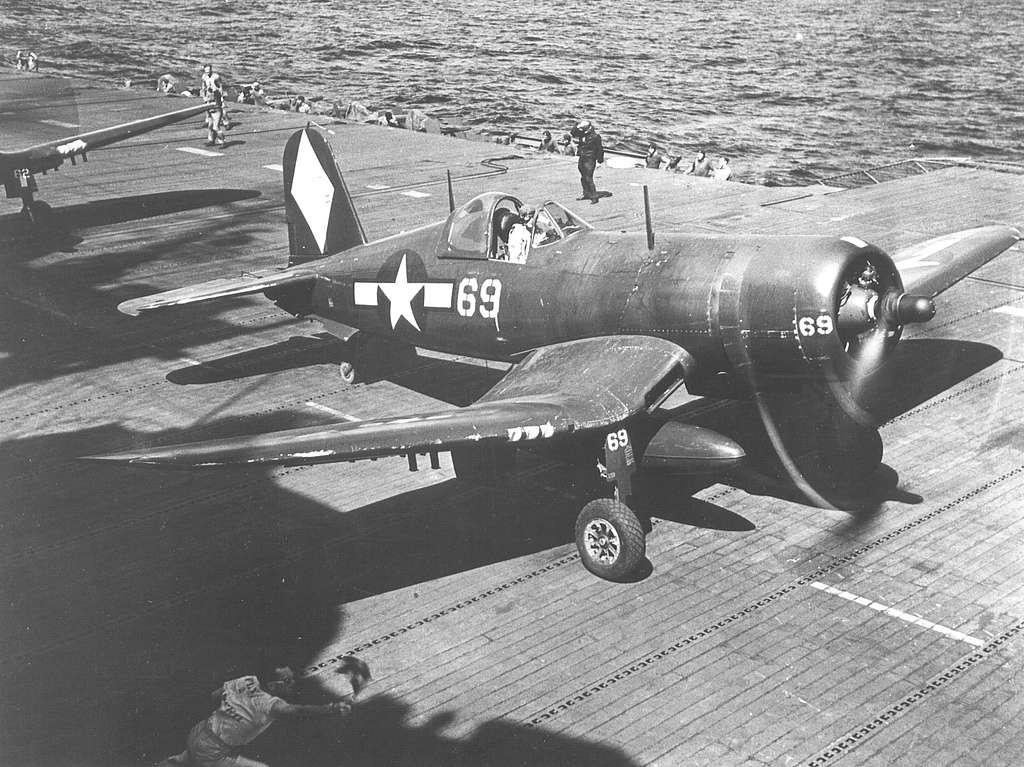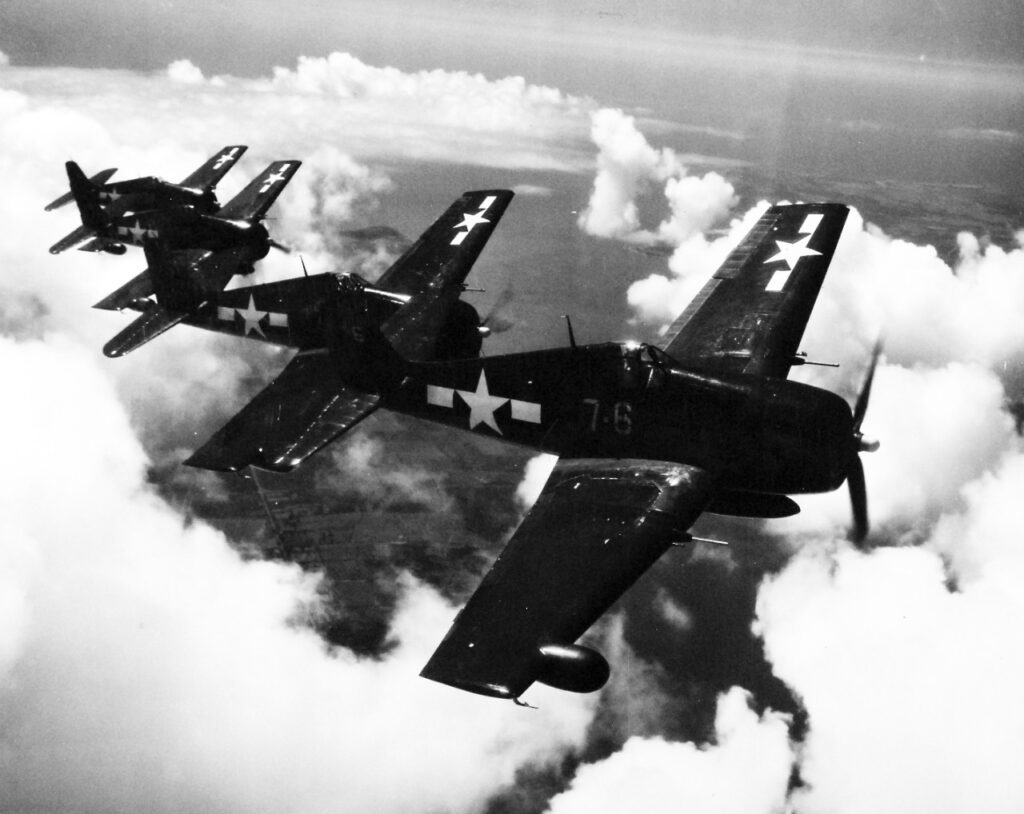USS Franklin Fields More Fighters (Part 2 of 2)
(Read part 1: USS Franklin Aircraft: Corsairs, Helldivers, And More!)
After finishing her repairs from the October 30, 1944 kamikaze attack, Big Ben departed Bremerton, Washington, and arrived in Alameda, California to pick up her new air group, Air Group 5.
Going aboard the USS Franklin at NAS Alameda was unceremonious, to say the least. There was a sign at the quarterdeck that said simply, “Welcome aboard”-and that was it. Captain Leslie Gehres, the ship’s skipper, went a little further in the way of reception by inviting all the [air] squadron commanders for dinner. This was a nice gesture, but when he insisted on having pilots stand Watch on the way out, he was fiercely resisted. Pilots had to focus on their jobs, not on his watches.-Major Charles Weiland, Commander, VMF-4521
Send in the Marines!

As the kamikaze attacks continued and became more effective, the US Navy knew that it had to increase fleet force protection. But it faced several problems. First, it had cut back on naval aviator training in June 1944 thinking it had enough. Second, Grumman Hellcats were also in short supply. As a result, in December 1944, Admiral Earnest King, who wore the combined titles of Commander In Chief, US Fleet, and Chief of Naval Operations, ordered ten Marine air squadrons to become carrier-qualified and assigned to fleet carriers.2 These squadrons flew the F4U Corsair, a fighter that was more than a match for Japanese Zeros and was slightly faster than the Hellcat. Finally, the Corsair was also a formidable fighter-bomber, capable of carrying not just bombs, but also rockets, including the powerful Tiny Tim rocket.
Recognizing that the Japanese fleet was no longer a major threat, the Navy felt free to change the ratio of fighters to bombers and dive bombers. More fighters flew expanded combat air patrols (CAP) to protect the fleet against kamikazes and traditional bombing attacks. Offensive tactics evolved to assign more fighters to attack Japanese aircraft and their airfields. Air groups went from 54 fighters to 73. To make room aboard carriers, bomber numbers were reduced from 24 to 15, and torpedo planes dropped from 18 to 15.
When Franklin returned to the Pacific Theater in 1945, she was one of nearly a dozen Essex-class carriers. At the same time, the number of Navy and Marine air squadrons had grown so large that it was no longer possible to have an air group with the same numerical designation as its home carrier. Therefore, while still CV-13, Franklin now hosted Air Group 5 commanded by Commander E. B. Parker.
When she left for the Pacific the second time the number of aircraft grew from 96 to 108 (although some of these would be lost in training mishaps).*
USS Franklin Aircraft in March 1945

“Bombing 5” (VB-5) Flew “The Beast!”
VB-5, commanded by Lt. Commander John G. Sheridan, flew 15 SB2C-4E Helldiver Dive Bombers. Nicknamed “The Beast” by the men who flew them, Helldivers were larger and much more finicky than the planes they replaced, the SBD Dauntless Dive Bomber.
“Torpedo 5” (VT-5) Flew TBM Avengers
VT-5, commanded by Lt.Commander Allan C. Edwards, flew 15 TBM-3 Avengers. (Note: There was little if any difference between the same versions of the TBF Avenger and the TBM Avenger. The “F” denoted that it was built by Grumman. As Grumman focused on manufacturing F6F Hellcats, the Avenger blueprints were turned over to General Motors, and TBMs were produced in GM’s factories. The “M” denoted a plane built by General Motors.)
“Fighting 5” (VF-5) was a Navy Squadron
VF-5, commanded by Lt. Commander MacGregor Kilpatrick flew 32 F4U-1D Corsairs. Fortunately, the early problems with the Corsair had been resolved by the time they arrived onboard Franklin. For those not familiar with the F4U, Vought designed it to have one of the most powerful engines, the Pratt & Whitney 18-cylinder Twin-Wasp engine, that produced 1850 horsepower (later it would be increased to 2000 hp). That engine required a propeller 13 feet, 4 inches in diameter, the largest of any fighter up to that time. For the propeller to clear the deck, the plane used gull wings to shorten the landing gear. The gull wings also reduced drag and increased pilot visibility.[efn-note]Musciano, 184-86[/efn_note]
Marine Squadrons VMF-214 and VMF-452
Like the Navy’s “Fighting 5, both Marine squadrons flew F4U-1Ds. VMF-214, commanded by Major Stan Bailey had gained fame in 1943 as the “Black Sheep Squadron,” under Major Greg, Pappy” Boyington. The squadron only had one sheep left, Major Bailey, who had been Boyington’s executive officer. All the other pilots in VMF-214 in March 1945 had joined the squadron after it rotated back to the US.
Major Charles “Pat” Weiland commanded VMF-452. Each squadron flew 18 Corsairs and had their own separate mechanics and support crews. 3
What happened to the surviving aircraft?
After his retirement, Weiland authored the book, Above and Beyond: Marine Air Combat in World War II, which described his time in combat from 1942 on Guadalcanal to 1945 and Okinawa. On the morning of 19 March 1945, one of 45 Navy and Marine Corsair pilots, he flew off the carrier before the Japanese bomber attacked. Their primary mission was to join other Task Force 58 fighter squadrons in a massive fighter sweep over the island of Honshu. 4 As they returned, radio chatter mentioning Franklin increased. In his book, Weiland wrote:
Then I saw the explosions and the boiling pall of smoke towering upward, and realized that this was my ship. This was the Franklin! It was a devastating sight. Even though I had already received a vector and instructions to land aboard the USS Hancock, which had a ready deck, I seem to be drawn hypnotically toward that cataclysmic scene. A sense of desolation overwhelmed me as I thought of my friends down there. How could they possibly survive that holocaust?5
Weiland and nine others landed aboard Hancock. Other returning planes landed on other carriers. Most would temporarily join other squadrons in the next few days to attack Japan again.
No aircraft would ever land aboard Franklin again. In the hours after the attack, she would lose power and the USS Pittsburgh (CA-72) would take her under tow moving her slowly away from Japan. Once the crew restored power, she cast off the tow. returning first to Ulithi, then Pearl Harbor, and finally to New York’s Brooklyn Naval Yard. Although repaired, she would never see service again.
In Memoriam
The USS Franklin Museum Association’s website lists the following numbers of those air squadron officers and enlisted men killed in action:
- Air Group 13 (July-October 1944) 50 (the majority in the kamikaze attack on 30 October.)
- Air Group 5 (Navy squadrons only, time period March 1945) 61
- VMF-214 (March 1945) 36
- VMF-452 (March 1945) 34
(The above numbers do not include deaths among the ship’s crew.)
Did you arrive here via a search engine? I am the author of the forthcoming book, Heroes By The Hundreds: The Story of the USS Franklin (CV-13). In addition to writing about the bravery of the crews that saved her, I will be writing about the lessons we can learn in leadership and crisis management. I’ll also write about the changes the US Navy made as a result of those lessons learned.
I send out a monthly newsletter, Glenn’s After-Action Report, writing about subjects I find interesting in my research. You can sign up for it below. Feel free to leave a comment or ask a question. Thanks for reading.-Glenn
*There is a minor discrepancy among sources as to the exact number of aircraft aboard Big Ben. This most likely has to do with whether or not the six F6Fs are included in the total for VF-5. The total number could be anywhere between 104 and 108 aircraft onboard when she left the mainland for the war zone.
Footnotes
1 Comments
Leave a Comment
You must be logged in to post a comment.
[…] 1620 an SB2C divebomber crashed into a barrier protecting parked aircraft. The three-man crew escaped uninjured, but the […]